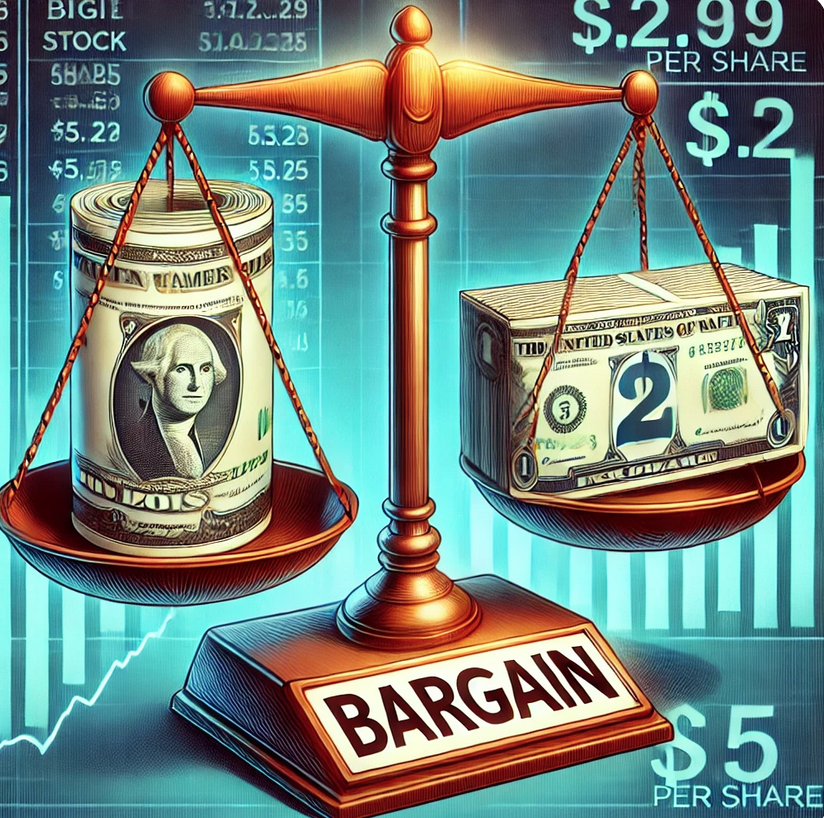by Fred Fuld III
Investing in stocks that are trading below their cash per share can present compelling opportunities, particularly for value-oriented investors. This situation arises when a company’s market capitalization is less than the total cash (or cash equivalents) it holds, divided by the number of shares outstanding. In effect, it means you are buying cash at a discount, potentially gaining access to additional assets — such as property, equipment, or intellectual property — for free.
One of the primary advantages of this type of investment is the built-in margin of safety. This concept, popularized by Benjamin Graham, suggests that when you’re paying less than a company’s net cash value, your downside is limited. Even if the business performs poorly or winds down operations, the liquidation value of its assets — particularly cash — may exceed the stock’s current market price, reducing the risk of a permanent loss.
Such companies also tend to attract activist investors who recognize the disparity between intrinsic and market value. These activists may push for actions like special dividends, share buybacks, or even the sale or liquidation of the company, all of which can unlock hidden value for shareholders. Similarly, businesses trading below cash per share can become attractive acquisition targets. A buyer may see an opportunity to extract immediate value by taking control of the cash and monetizing other assets or operations.
A strong cash position also offers optionality. Companies with excess cash can invest in new opportunities, navigate downturns without raising debt, or repurchase shares when they are undervalued. If managed wisely, these actions can significantly enhance long-term shareholder value.
Investors should note, however, that not every company trading below cash per share is a bargain. Sometimes, cash balances may not be as liquid or accessible as they appear — for instance, if they are held in overseas accounts subject to repatriation taxes. Moreover, a high cash position might be misleading if the company is rapidly burning through it due to poor operations or heavy losses. Poor management, regulatory issues, or the risk of delisting can also justify why the market has heavily discounted the stock.
There are several examples of biotechnology stocks that are trading below cash per share, such as Olema Pharmaceuticals, Inc. (OLMA), which is a clinical-stage biopharmaceutical company, focusing on development and commercialization of targeted therapies for women’s cancers.
The company is debt free, trades at 84% of book value, and 82% of cash per share. The important factor you have to be aware of with biotechs is the burn rate, which in simple terms, relates to how long the company will last assuming losses will continue to eat away at the cash position, assuming no additional funding. In the case of Olema, it has $434 million in cash but losing about $129 million per year. This means that the company can hold out for about three and a third years, assuming all else remains equal.
One company in the industrial sector that trades below cash is NET Power, Inc. (NPWR). The company is a U.S.-based energy technology company founded in 2010 and headquartered in Durham, North Carolina. The company is developing the NET Power Cycle, a proprietary natural gas power generation system that inherently captures carbon dioxide [CO₂] emissions. This technology aims to produce low-cost, clean, and reliable electricity while minimizing environmental impact.
The NET Power Cycle utilizes a highly recuperative oxy-combustion process, combining oxy-combustion and a supercritical CO₂ power cycle. This design enables the system to generate electricity while capturing CO₂ emissions, reducing air pollutants such as sulfur oxides [SOX], nitrogen oxides [NOX], and particulates. The company targets a range of customers, including electric utilities, oil and gas companies, midstream operators, technology firms, and industrial facilities, both domestically and internationally.
NET Power operates a demonstration facility in La Porte, Texas, which serves as a proof of concept for its technology.The company is also working on Project Permian and other development projects to expand its technology’s deployment.
The company has no debt and trades at a 25% discount to cash per share, and an incredible 20% of book value. As of May 16, 2025, NET Power’s market capitalization was approximately $370 million. The company has experienced significant stock price volatility, with a 52-week high of $14.28 and a 52-week low of $1.56.
Financially, NET Power reported a net loss of $157.12 million over the trailing twelve months, with revenue of $250,000. The company had $533 million in cash, cash equivalents, and investments as of the end of 2024, providing a solid financial foundation for ongoing development and deployment efforts.
NET Power’s major shareholders include Occidental Petroleum Corporation, which holds a 45.18% stake, and other investors such as Greenlight Capital.
One other stock trading below cash with a relatively small amount of debt is Green Dot Corp. (GDOT). The company is a financial technology and registered bank holding company headquartered in Austin, Texas. Founded in 1999 by Steve Streit, the company initially focused on providing prepaid debit cards for teenagers to shop online. Over time, Green Dot expanded its services to cater to the “unbanked” and “underbanked” populations, offering a range of financial products and services.
Today, Green Dot operates as a “branchless bank,” delivering banking and payment solutions through a cloud-based technology platform. The company offers various products, including prepaid MasterCard and Visa cards, mobile banking accounts, and secured credit cards. Green Dot’s services are available through a vast network of retail locations, online platforms, and partnerships with companies like Apple, Uber, Intuit, and Walmart.
One of Green Dot’s notable offerings is GO2bank, a digital and mobile bank account designed to provide simple, secure, and useful banking services, particularly for Americans living paycheck to paycheck. Additionally, the company operates the Green Dot Network, which includes over 90,000 retail distribution and cash access locations nationwide, enabling customers to deposit and withdraw funds conveniently.
Green Dot has also ventured into embedded finance through its platform, Arc by Green Dot, which combines the company’s banking and money processing capabilities to support businesses at various stages of growth. Furthermore, the company owns Santa Barbara Tax Products Group, a subsidiary that processes more than 14 million tax refunds annually.
The stock amazingly trades at only 28% of the cash per share, and 55% of book value per share. Although they lost 12 cents a share for the latest reported year, the estimated earnings for next year is $1.47 per share. Sales have grown by 19% year-over-year and by over 23% for the latest quarter versus the same quarter last year.
As of May 17, 2025, Green Dot’s stock price is $9.44 per share, with a market capitalization of approximately $500 million. The company employs around 1,200 people and continues to focus on expanding its digital banking services and partnerships to reach a broader customer base.
While rare, stocks selling below cash per share with little or no debt can signal a market overreaction or neglect, and these shares may rebound sharply when sentiment changes or fundamentals improve.
Disclosure: Author didn’t own any of the above shares at the time the article was written.


